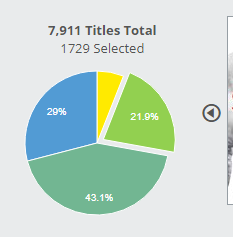The Stock Analysis graph will quickly show you how your inventory is performing, using the Shelf Days measurement. You can view your entire inventory or use your filters to view smaller, targeted portions. Those Saved Filters can be quite intricate, if you wish. You could, for example, easily see how kids paperback books about pirates perform in your shop, or combine a number of categories to measure a large swath of your shop all at once. Some users have created filter sets that represent physical areas of their shops, according to which of their categories are represented there. For example you can measure how categories in the front right corner of your shop perform, and then see how that compares to categories in the back left corner. Filtering by publisher, imprint, BISAC Codes, POS Category, Year of Publication, etc. would all be worth a look.
You can also, of course, just look at everything. Here’s an example of a shop that is doing particularly well:
A slim 4.6% of their titles are “Stale/Cool,” while almost 42% are “Hot/Fresh.”
Here’s another (slightly smaller) shop’s Stock Analysis:
This one has a much larger percentage of Stale titles, at 29%. (That’s the blue slice of the pie) as well as a much smaller percentage of Hot (green) titles. So basically the second store simply has more titles that have sat without selling for a longer period. Both could conceivably be considered relatively healthy, although the first one is clearly a much more profitable store.
So essentially what you’re doing with this tool is measuring the ‘health’ of your shop, a category, or a specific grouping of titles, based on how/whether they’re selling. Based on this information, you can easily create a list of titles to return (or pull for some more aggressive merchandising) by simply printing out the list of Stale titles, edited as you wish.
This process can, at first, be daunting if it’s been a while since you’ve purged your inventory of unsold titles. The one great and unavoidable truth of the book business, though, is that the books just never stop coming. It’s a good idea to make room, and to (let us be blunt) carry books that your customers actually want to buy.
If your inventory is a conversation you have with your customers, what they buy is just one part of their response. What they leave sitting on the shelf is the other part of the conversation, and one that is too often ignored.
Doing this analysis on a regular basis will make you a smarter and better-informed buyer and bookseller, as you’ll have a much clearer vision of what actually moves…rather than what you wished moved.


